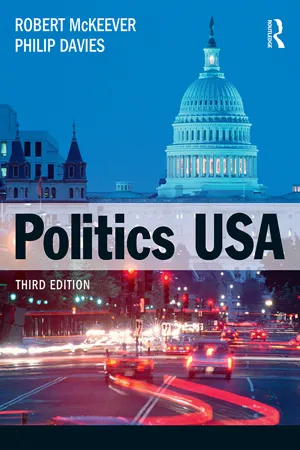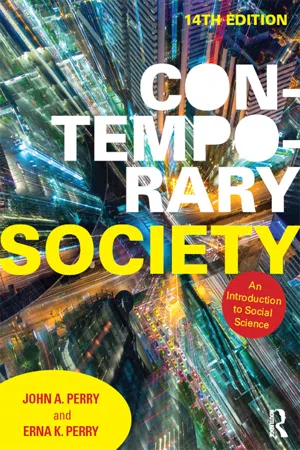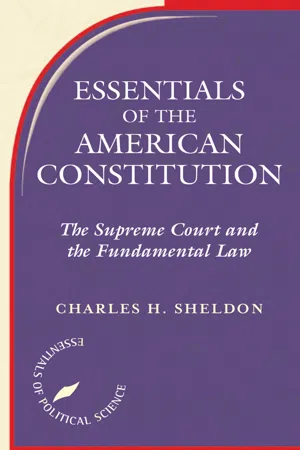American Constitution
The American Constitution is the supreme law of the United States, serving as the foundation for the country's government and legal system. It outlines the structure of the government, the rights of the people, and the division of powers between the federal and state governments. Ratified in 1788, it has since been amended 27 times to reflect the changing needs of the nation.
6 Key excerpts on "American Constitution"
- eBook - ePub
- Robert J. McKeever, Philip Davies(Authors)
- 2014(Publication Date)
- Routledge(Publisher)
...The Constitution provides not only a framework for government in America, but also a way of thinking about government. For inseparable from the Constitution is the idea of constitutionalism – the belief that all things governmental and political must comply with the principles set out in that document. The US Constitution was drafted in 1787 and came into force in 1789. Yet it is no mere historical relic. Because it has been regarded as a ‘living document’, subject to new interpretations as well as formal amendment, it has developed in line with the socio-economic and political transformation of America from a rural, eastern seaboard nation to a post-industrial, continental power that dominates the world in so many respects. As you might expect, just as America has not achieved this transformation without struggle and contention, so too the Constitution has been fought over and its development has been far from smooth. Nevertheless, it remains the keystone of American government and any understanding of American politics must begin with an appreciation of the Constitution and constitutionalism. The origins of the Constitution of 1787 The Constitution of 1787 has philosophical roots in the progressive European thought of the eighteenth century, but its driving force was a distinctly practical consideration: how to replace British colonial rule with a government that was effective but not oppressive. The United States had been wrestling with this problem since the Declaration of Independence in 1776, but even after the successful conclusion of the War of Independence in 1783, it still had not found a solution. Part of the difficulty lay in the fact that achieving independence and implementing self-government were distinctly different projects, and Americans took some time to make the transition from the one to the other...
- eBook - ePub
Contemporary Society
An Introduction to Social Science
- John A Perry, Erna K Perry(Authors)
- 2016(Publication Date)
- Routledge(Publisher)
...Chapter 15 © Rawpixel.com/Shutterstock The Government of the United States of America IN THIS CHAPTER, YOU WILL LEARN • the historical sequence in the establishment of American political institutions; • about the implications of the executive branch; • the weaknesses of the legislative branch; • the functions of the judicial branch; and • the importance of limited government. We hold these truths to be self-1evident, that all men are created equal, that they are endowed by their Creator with certain inalienable Rights, that among these are Life, Liberty and the pursuit of Happiness. We the People of the United States, in Order to form a more perfect Union, establish Justice, insure domestic Tranquility, provide for the common Defense, promote the general Welfare, and secure the Blessings of Liberty to ourselves and our Posterity, do ordain and establish this Constitution for the United States of America. E very American schoolchild is familiar with at least some of these words. They have become the myths with which we clothe parts of our history. Their sound evokes an emotional response, just like the American flag waving on the Fourth of July. The words, of course, are part of the documents we hold sacred: the Declaration of Independence and the Constitution of the United States. As familiar as they are to us, the posterity mentioned in the preamble to the Constitution, few of us are likely to have thought much about what such documents mean, and especially what they meant then, when they were written. For indeed they were spectacular for their times, and the political system that was spawned by the ideology behind them, cumbersome and inefficient as it may be, has served American society quite well for more than 200 years. That is a record few societies have been able to equal. The emergence of the United States as a nation goes back to 1776, at the time of the Declaration of Independence...
- eBook - ePub
American Constitutional Law
Introductory Essays and Selected Cases
- Donald Grier Stephenson Jr., Alpheus Thomas Mason(Authors)
- 2021(Publication Date)
- Routledge(Publisher)
...2 The Constitution, the Supreme Court, and Judicial Review DOI: 10.4324/9781003164340-3 Judicial review represents an attempt by American Democracy to cover its bet. —Professor Edward S. Corwin (1942) The Constitution of 1787 and its 27 amendments, reprinted near the beginning of this book, can be read in about half an hour. One could memorize the written document word for word and still know little or nothing of its meaning. The reason is that the body of rules known as constitutional law consists primarily of decisions and opinions of the U.S. Supreme Court—the gloss that the justices have spread on the formal document. Charles Warren asked us not to forget that “[h]owever the Court may interpret the provisions of the Constitution, it is still the Constitution which is law and not decisions of the Court.” But future justice and chief justice Charles Evans Hughes bluntly asserted that “[t]he Constitution is what the Judges say it is.” Furthermore, recurrent declarations of reverence for the “ark of our covenant,” as Chief Justice Taft called the Constitution, stand in sharp contrast to the reality that most Americans do not adequately understand the Constitution. Popular perceptions about the Constitution are frequently at odds with the document itself, making the American Constitution in its broadest sense greater than the sum of its parts. Myth wars with fact both within and without the Court. Granting and Limiting Power In the United States, the Constitution alone is supreme. All agencies of government stand in the relationship of creator to creatures. There is, Woodrow Wilson observed, “no sovereign government in America.” But Wilson was not blind to the fact that government means action. “Power belongs to government, is lodged in organs of initiative; control belongs to the community, is lodged with the voters”—and the courts. Constitutionalism...
- eBook - ePub
- David Mckay(Author)
- 2018(Publication Date)
- Routledge(Publisher)
...3 Constitutional Government The American Constitution is the most wonderful work ever struck off at a given time by the brain and purpose of man. —W. E. Gladstone Good government should be sufficiently neutral between the different interests and factions to control one part of the society from invading the rights of another, and at the same time sufficiently controlled itself, from setting up an interest adverse to that of the whole society. —James Madison Almost all governments pay formal allegiance to a written or (more rarely) unwritten constitution, but in few countries is the constitution a real and continuing constraint on the exercise of power. Even more rarely do constitutions survive political and social changes, invasions, and wars. The American Constitution is unusual, both because it has remained almost unaltered since its ratification in 1789, and because it continues as a major source of authority in the political system. Indeed, even the most cursory examination of America’s basic political institutions—Congress, the presidency, federalism, the electoral system—instantly shows the influence of the Constitution. To most observers, the apparent resilience of the Constitution and constitutionalism is one of the most remarkable features of American politics, and one that requires some explanation. Several important questions are raised by this phenomenon: Why has the Constitution been amended so little through history? What real influence does it have today? In particular, by limiting the power of central government, has it served to aggravate the tension between the public’s expectations of government and the ability of political institutions to satisfy those expectations? Prerequisite to answering these questions is the crucial issue of why the Constitution took the shape it did. Origins Most dramatic regime changes following a revolution or war are quite easy to explain. France in 1789 was seething with discontent at a corrupt and insensitive monarchy...
- eBook - ePub
- Stephen L Wasby(Author)
- 2018(Publication Date)
- Routledge(Publisher)
...First, those responsible for endowing the Constitution with authority are those who ultimately are sovereign—namely, the people. Second, the Constitution’s legitimacy is accomplished by requiring an extraordinary and burdensome process to give it effect. The process must be more arduous than what is involved in ordinary legislation. Both fundamental endowments are articulated by Chief Justice John Marshall in Marbury v. Madison * (1803), where he said that the writing and ratifying of the Constitution were accomplished after “a very great exertion” and “the principles … so established are deemed fundamental” and “the authority from which they proceed is supreme.” 4 The authority is announced in the Preamble to the Constitution, which begins with “We the people” and ends with “do ordain and establish this Constitution for the United States of America.” That authority is further confirmed in Article 5 of the Constitution. In order to amend the basic law, which is akin to the original task of drafting and approving the document, a formidable gauntlet must be overcome. The Congress, whenever two-thirds of both Houses shall deem it necessary, shall propose Amendments to this Constitution, or, on the Application of the Legislatures of two-thirds of the several States, shall call a Convention for proposing Amendments, which, in either Case, shall be valid to all Intents and Purposes, as Part of this Constitution, when ratified by the Legislatures of three-fourths of the several States, or by Conventions in three-fourths thereof. To accomplish the sanctity necessary to gain trust and to compel obedience, the Constitution as symbol looks to the past. Concepts which had “long antedated the rise of science,” and had resulted from the struggle to bring some dignity, “security and significance” to the human existence are said to be embodied in provisions of the Constitution...
- eBook - ePub
Judges on Judging
Views from the Bench
- David M. O′Brien(Author)
- 2016(Publication Date)
- CQ Press(Publisher)
...Chapter 13 Commentaries on the Constitution of the United States Joseph Story Justice, Supreme Court of the United States (1811–1845) Preface T he reader must not expect to find in these pages any novel views, and novel constructions of the Constitution. I have not the ambition to be the author of any new plan of interpreting the theory of the Constitution, or of enlarging or narrowing its powers by ingenious subtleties and learned doubts. My object will be sufficiently attained, if I shall have succeeded in bringing before the reader the true view of its powers maintained by its founders and friends, and confirmed and illustrated by the actual practice of the government. The expositions to be found in the work are less to be regarded, as my own opinions, than as those of the great minds, which framed the Constitution, or which have been from time to time called upon to administer it. Union subjects of government it has always appeared to me, that metaphysical refinements are out of place. A constitution of government is addressed to the common sense of the people; and never was designed for trials of logical skill, or visionary speculation. . . . Chapter IV. Who Is Final Judge or Interpreter in Constitutional Controversies Sec. 374. The constitution, contemplating the grant of limited powers, and distributing them among various functionaries, and the state governments, and their functionaries, being also clothed with limited powers, subordinate to those granted to the general government, whenever any question arises, as to the exercise of any power by any of these functionaries under the state, or federal government, it is of necessity, that such functionaries must, in the first instance, decide upon the constitutionality of the exercise of such power. It may arise in the course of the discharge of the functions of any one, or of all, of the great departments of government, the executive, the legislative, and the judicial...





